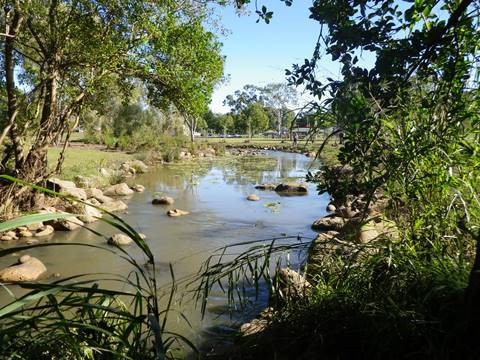|
|
Bypass fishwayBypass fishway Select from the tabs below Disclaimer: In addition to the standard disclaimer located at the bottom of the page, please note the Fishways (biopassage structures) disclaimer. Other name/sNature like fishway DescriptionBypass fishways are usually low gradient earthen or rocky channels that mimic the structure of natural streams[2].They appear much like a natural stream with pools, meanders and riffles and an earthen or rocky channel, and have the ability to move all species and sizes when properly designed. They can also provide aesthetic and stream habitat values[1]. These fishways typically combine rock ramp fishways with resting pools between, though some recent designs have combined more technical designs (cone fishways) with large resting pools between fishways to ascend larger barriers exceeding 10 m high (Andrew Berghuis pers. comm.). Bypass fishways are generally used on small to medium barriers between 2 and 6 m high[3]. Few fish bypasses have been constructed in Australia, however a bypass has been constructed on a 10 m high structure in Weipa (Andrew Berghuis pers. comm.) and at Baldwin Swamp, Bundaberg. Sub-typesThere are three main sub-types of bypass fishways, based on the predominate construction material and style of the flow control structure between the pools: channel, rock ramp and cone. The channel style has a mostly earthen bed and bank and mimics a natural channel or waterway. The rock ramp style has flow control structures constructed of rock and is very similar to a rock ramp fishway but tends to be much longer with larger pools and bypasses the waterway rather than being built into the waterway like a traditional rock ramp fishway. Traditional bypass fishways used this rock ramp design; however, newer designs may use other technologies such as cone fishways, as the flow control structure. References
Last updated: 10 May 2021 This page should be cited as: Department of Environment, Science and Innovation, Queensland (2021) Bypass fishway, WetlandInfo website, accessed 8 May 2025. Available at: https://wetlandinfo.des.qld.gov.au/wetlands/management/fish-passage/technologies/fishway-options/bypass/ |

 — Department of the Environment, Tourism, Science and Innovation
— Department of the Environment, Tourism, Science and Innovation

